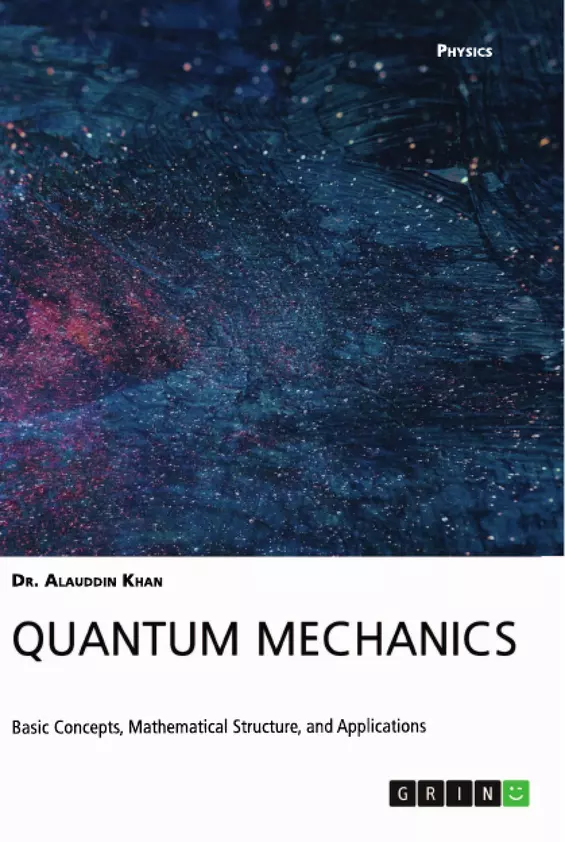This book has been written with the notion that a wave is associated with a material particle i.e. waves and particles coexist. Heisenberg's uncertainty principle has been described taking this into account. The book consists of a total of 17 chapters. The two initial chapters discuss the development and basic concepts of Quantum Mechanics. The third chapter is dedicated to the mathematical structure of Quantum Mechanics. The fourth deals with Matrix formulation after which the fifth chapter discusses applications to one-dimensional [1D] problems. The sixth chapter is on Quantum Mechanics of Linear Harmonic Oscillator.
Discussion on Atomic Orbitals of a hydrogen atom and a hydrogen atom of Quantum Mechanics are treated in two separate chapters namely the seventh and eighth chapters. Orbital and general angular momentums are treated in two separate chapters. Among numerous other topics Matrix formulation of Quantum Mechanics, Quantum theory of scattering, Quantum dynamics,[Three pictures of time development]Dirac's Relativistic Quantum Mechanics, Born approximation, Time dependent and Time independent perturbation theory[both generate and non-degenerate case],Variational method, and WKB approximation method have also been discussed.
Inhaltsverzeichnis (Table of Contents)
- Brief description of the book
- PREFACE
- Acknowledgements
- Dedication
- Contents
- Brief description of the book
- Chapter 1: Introduction
- Chapter 2: The Old Quantum Theory
- Chapter 3: Mathematical Structure of Quantum Mechanics
- Chapter 4: Matrix Formulation of Quantum Mechanics
- Chapter 5: Applications to One-Dimensional Problems
- Chapter 6: Quantum Mechanics of the Linear Harmonic Oscillator
- Chapter 7: Atomic Orbitals of a Hydrogen Atom
- Chapter 8: Quantum Mechanics of a Hydrogen Atom
- Chapter 9: Orbital Angular Momentum
- Chapter 10: General Angular Momentum
- Chapter 11: Identical Particles
- Chapter 12: Quantum Theory of Scattering
- Chapter 13: Quantum Dynamics
- Chapter 14: Dirac's Relativistic Quantum Mechanics
- Chapter 15: Time Independent Perturbation Theory
- Chapter 16: Time Dependent Perturbation Theory
- Chapter 17: Variational Method and WKB Approximation
Zielsetzung und Themenschwerpunkte (Objectives and Key Themes)
This textbook aims to provide a comprehensive understanding of quantum mechanics for undergraduate and master's level students, while also serving as a reference for anyone interested in the field. It covers the foundational concepts, mathematical formalism, and illustrative examples of quantum mechanics, encompassing both its theoretical framework and practical applications.
- Development and basic concepts of quantum mechanics
- Mathematical structure of quantum mechanics and its applications
- Matrix formulation and its application to one-dimensional problems
- Quantum mechanics of the linear harmonic oscillator and atomic orbitals
- Quantum theory of scattering, quantum dynamics, and perturbation theory
Zusammenfassung der Kapitel (Chapter Summaries)
The first two chapters of the book provide an introduction to quantum mechanics, exploring its historical development and key concepts. Chapter 3 delves into the mathematical structure of quantum mechanics, laying the foundation for subsequent chapters. Chapter 4 introduces the matrix formulation of quantum mechanics, which is then applied to one-dimensional problems in Chapter 5. Chapter 6 explores the quantum mechanics of the linear harmonic oscillator, a fundamental system in quantum mechanics. Chapter 7 and 8 discuss the atomic orbitals of a hydrogen atom and the quantum mechanics of a hydrogen atom, respectively. Chapters 9 and 10 cover orbital angular momentum and general angular momentum. Subsequent chapters delve into more advanced topics, including identical particles, scattering theory, quantum dynamics, Dirac's relativistic quantum mechanics, perturbation theory, and variational methods. The book concludes with a discussion of the WKB approximation method, a powerful technique for solving quantum mechanical problems.
Schlüsselwörter (Keywords)
The book focuses on key concepts in quantum mechanics, including wave-particle duality, Heisenberg's uncertainty principle, Schrödinger's equation, matrix mechanics, atomic orbitals, scattering theory, perturbation theory, and relativistic quantum mechanics. It also covers important methods such as variational methods and the WKB approximation. The book aims to provide a comprehensive understanding of the fundamentals of quantum mechanics and its applications in various areas of physics.
- Citar trabajo
- Alauddin Khan (Autor), 2019, Quantum Mechanics. Basic Concepts, Mathematical Structure and Applications, Múnich, GRIN Verlag, https://www.grin.com/document/492165



